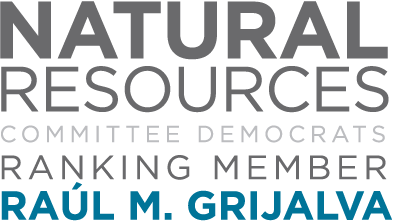
Federal Lands
From the rim of the Grand Canyon in Arizona to the crown of the Statue of Liberty in New York, to the peaks of Mount Denali in Alaska, America’s public lands include some of the most iconic landscapes and treasured places in the world.
The Subcommittee on Federal Lands oversees this collection of crown jewels, and the federal agencies tasked with their protection.
Committee Democrats
-
Ranking Member
-
Colleen Hanabusa
Hawaii 1st District -
Niki Tsongas
Massachusetts 3rd District -
Alan Lowenthal
California 47th District -
Ruben Gallego
Arizona 7th District -
A. Donald McEachin
Virginia 4th District -
Anthony Brown
Maryland 4th District -
Jimmy Gomez
California 34th District -
Raúl M. Grijalva
Arizona 3rd District
 National Park Service: Founded in 1916 and manages more than 84 million acres in 407 units. In 2014, the National Park Service welcomed 292 million visitors, employed 21,000 people and managed an annual budget of almost $3 billion.
National Park Service: Founded in 1916 and manages more than 84 million acres in 407 units. In 2014, the National Park Service welcomed 292 million visitors, employed 21,000 people and managed an annual budget of almost $3 billion.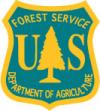 Forest Service: Founded in 1905 and currently manages 193 million acres in 155 national forests and 20 national grasslands – roughly 30% of all federal land. The Forest Service employs 30,000 people and manages an annual budget of roughly $6 billion.
Forest Service: Founded in 1905 and currently manages 193 million acres in 155 national forests and 20 national grasslands – roughly 30% of all federal land. The Forest Service employs 30,000 people and manages an annual budget of roughly $6 billion.  Bureau of Land Management: Founded in 1946 and manages 245 million surface and 700 million subsurface acres – roughly 40% of all federal land. The Bureau of Land Management manages 380 recreational sites, 21 national conservation areas, 16 national monuments and vast areas of open public land. It employs approximately 10,000 people and manages an annual budget of roughly $1 billion.
Bureau of Land Management: Founded in 1946 and manages 245 million surface and 700 million subsurface acres – roughly 40% of all federal land. The Bureau of Land Management manages 380 recreational sites, 21 national conservation areas, 16 national monuments and vast areas of open public land. It employs approximately 10,000 people and manages an annual budget of roughly $1 billion.  Fish & Wildlife Service: Founded in 1940, the Fish & Wildlife Service is dedicated to the management of fish, wildlife, and natural habitats. It manages over 560 National Wildlife Refuges and thousands of small wetlands and other special management areas covering over 150 million acres, as well as 70 National Fish Hatcheries and 65 Fishery Resource Offices, and 86 Ecological Services Field Stations. The Fish & Wildlife Service employs approximately 9,000 people at facilities across the U.S. and manages an annual budget of roughly $2.32 billion. For more information, visit the Wildlife and Endangered Species page on our website.
Fish & Wildlife Service: Founded in 1940, the Fish & Wildlife Service is dedicated to the management of fish, wildlife, and natural habitats. It manages over 560 National Wildlife Refuges and thousands of small wetlands and other special management areas covering over 150 million acres, as well as 70 National Fish Hatcheries and 65 Fishery Resource Offices, and 86 Ecological Services Field Stations. The Fish & Wildlife Service employs approximately 9,000 people at facilities across the U.S. and manages an annual budget of roughly $2.32 billion. For more information, visit the Wildlife and Endangered Species page on our website.The Greater Grand Canyon Heritage National Monument Act
-
On Jan. 6, 2017, Ranking Member Raúl M. Grijalva (D-Ariz.) reintroduced the Greater Grand Canyon Heritage National Monument Act – a bill establishing a new national monument to the north and south of the Grand Canyon that protects a vital watershed and celebrates the long local history and deep cultural roots of the region’s Native American Tribes. A map of the proposed Monument is available here.
What Would Creating a National Monument Mean?
This summary briefly explains how the Monument would work, with an emphasis on collaborative decisionmaking with local stakeholders and Tribal leaders.
If the national monument is created, it will “preserve, and if necessary restore:”
- Native cultural sacred lands and tribal resources
- National biological, ecological, cultural, scientific and other values found in the Grand Canyon, including above-ground tributaries, springs and interconnected groundwater, and
- The opportunity to experience and enjoy the diverse tribal resources, landscape, wildlife, water flows and recreational use of the lands included in the national monument
What's the Environmental Impact?
In 2012, then-Secretary of the Interior Ken Salazar announced a 20-year moratorium on new uranium mining claims on more than 1 million acres of public land surrounding the Grand Canyon. Uranium exposure continues to harm Northern Arizona residents, including Tribal communities. In order to protect many of Northern Arizona’s most sacred Native American sites and ecologically sensitive areas, Rep. Grijalva’s proposal – crafted in consultation with Tribal leaders from around the region – would make that moratorium permanent within the Monument.
By extending National Monument status to areas north and south of Grand Canyon National Park that currently enjoy lower levels of protection, Grijalva's proposal ensures that the Grand Canyon itself and the communities in the region will enjoy a higher level of environmental conservation in perpetuity.
Is This Good for the Economy?
The region will clearly benefit from the Monument, although some mining interests have tried to argue otherwise. You can learn more about how the Greater Grand Canyon Heritage National Monument will help the regional economy at the Myths and Facts page here.
Do Tribes Support the Proposal?
Tribal leaders overwhelmingly support the Grijalva plan. You can read their resolutions and letters of support here.
Who Else Supports the Designation?
Members of the City Council of Flagstaff have been sending letters of support for Grijalva's bill.
Arizona farmers, ranchers, and agricultural businesses sent a letter to Interior Secretary Sally Jewell and Agriculture Secretary Thomas Vilsack urging them to support protecting the watershed of the Grand Canyon as a national monument.
Is The Idea Popular With the Public?
A recent national survey of registered voters likely to participate in the November 2016 election revealed overwhelming public support for establishing the Greater Grand Canyon Heritage National Monument, with 82 percent saying they back its creation. This support is strong across political parties, demographic groups and geographical areas, with majority support in every major subgroup of the American electorate. This support stems from a widespread belief that more needs to be done to protect the land, air and water around Grand Canyon National Park. Half (50%) say they would be “more likely” to vote for a Presidential candidate who supported the creation of the Greater Grand Canyon National Heritage Monument. For more information, view the complete survey analysis.
On July 7, 2016, public supporters from all over the country delivered more than 550,000 petition signatures to President Obama urging him to protect the area as a national monument under the Antiquities Act. To learn more, check out the news coverage in the Phoenix New Times, KNAU Public Radio (NPR) and Arizona Daily Sun.
Arizonans strongly support establishing the Greater Grand Canyon Heritage National Monument and agree that it will enhance the region’s cultural, natural, recreational and scientific resources. According to a Feb. 18 report in the Arizona Republic:
Eighty percent of likely 2016 Arizona voters approve of a statewide plan for a Greater Grand Canyon Heritage National Monument exceeding 1 million acres and banning new uranium mines, according to the poll sanctioned by the Grand Canyon Trust.
The support included 95 percent of Democrats polled, 84 percent of independents and 65 percent of Republicans. More than half — 58 percent — of the respondents said they “strongly” support a monument.
What Is the Media Saying About It?
The proposal has been supported in National Geographic, the New York Times and many other outlets. For a full overview of media coverage, click here and scroll down to "The Greater Grand Canyon Heritage National Monument Act."
Tribal leaders and communities across the region – joined by sportsmen and women, hunters, anglers and outdoors enthusiasts – support the monument. They all agree: It’s time to establish the Greater Grand Canyon Heritage National Monument and further protect one of the crown jewels of our National Park System.
Promoting the Recreation Economy
- The real economic engine fueling many communities is the recreation economy. The Outdoor Industry Association's economic report estimates that outdoor recreation creates $646 billion in direct consumer spending and $80 billion in federal, state, and local taxes (bigger than the pharmaceutical or automobile industry). According to the National Park Service, the national park system also generates $10 of economic activity for every $1 invested.
- Responsible land management practices preserve public lands for future generations and have little to no impact on recreation opportunities. Annual recreation visits to National Parks have increased by more than 75,000,000 visits since 1979, a nearly 40% increase, according the National Park Service's 2014 annual visitation summary report.
- Committee Democrats support reauthorization of the Federal Lands Recreation Enhancement Act (FLREA). FLREA improves recreation and visitor services, keeping most fees on-site for improvements that visitor’s desire, and makes recreation sites more accessible. For example, FLREA establishes a single national pass that can be used across recreation sites managed by all four land management agencies.
Why Wilderness Matters
Wilderness benefits all Americans
Wilderness areas belong to all Americans and encompass some of our most breathtaking places: snow-capped mountains, giant redwoods, roaring rivers, and wildflower-filled deserts. The National Wilderness Preservation System also provides vital habitat to birds, animals, and plants. You might witness an endangered California condor soaring high above the San Rafael Wilderness in California, or catch a glimpse of an American alligator in the St. Marks Wilderness in Florida.
- Wildlife increases economic prosperity and quality of life. Beyond scenic beauty and homes to wildlife, wilderness areas provide places for people, too. Every year, millions of Americans camp, hike, ride horses, and hunt on lands within the National Wilderness Preservation System. During these visits, Americans:
- Spend $646 billion annually which supports 6.1 million American jobs in the Outdoor Industry, according to the 2012 Outdoor Recreation Economy report.
- Contribute to both local and national economies by contributing $39.9 billion in federal tax revenue, and $39.7 billion in state/local tax revenue.
- Increase employment, between 1970 and 2010 employment increased by 297% in rural counties in the West with land bases that are more than 20% protected federal land, and 345% in counties that are more than 30% protected lands, according to the Headwaters Economics 2012 report.
- Urban communities value greenery. As our society continues to urbanize, many communities place a greater value on having scenic backdrops to their homes and nearby open space for recreation. According to a recent study, private homes near parks, wilderness and other protected areas can have property values 20% higher than similar properties elsewhere. In addition, protecting lands as wilderness also helps maintain healthy, intact ecosystems that offer valuable services. Ecosystem services provide billions of dollars of benefits to the American people, from forests that clean the air we breathe and filter our drinking water, to wetlands that provide stormwater capture.
- Wilderness is a bipartisan tradition. Wilderness lands safeguard our nation's cultural heritage including Native American sacred sites and vestiges of early American history. Numerous wilderness areas including the Gila wilderness in New Mexico contain Native American petroglyphs and other areas of significance.
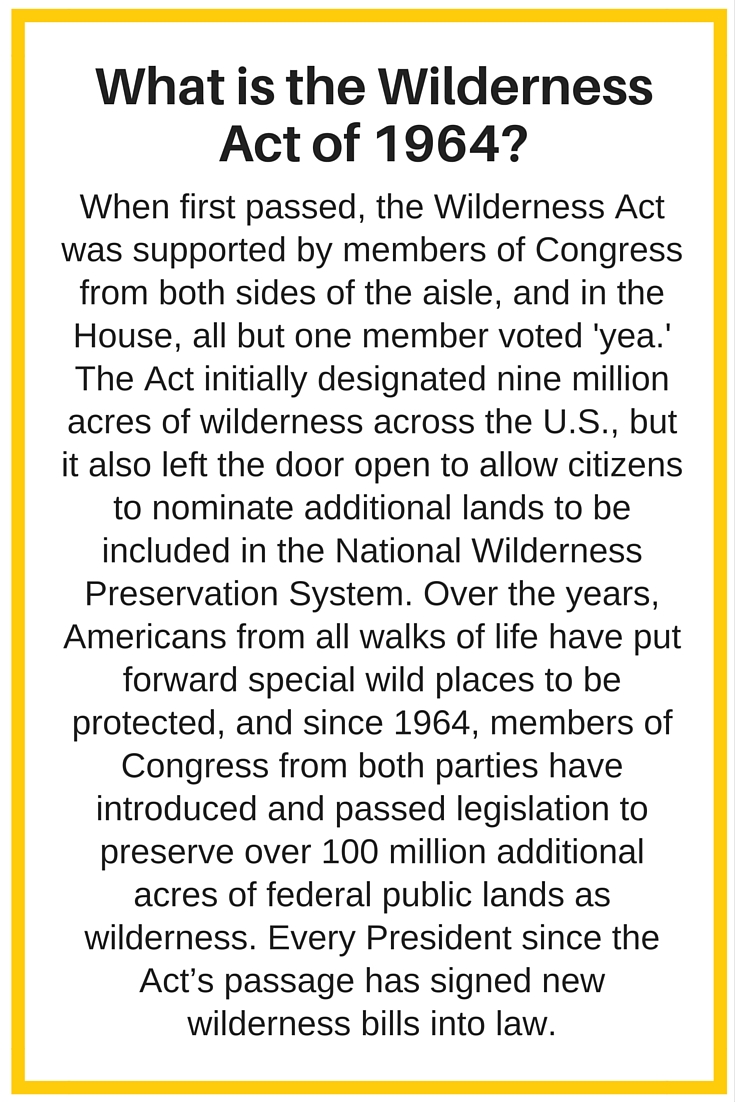 Wilderness is a special designation reserved for our wildest lands. Only Congress can designate wilderness areas under the Wilderness Act of 1964. When a new wilderness bill is passed, the lands are protected in perpetuity for current and future generations. Wilderness is considered the strongest kind of protection that federal public lands can receive because it protects lands from development, new mining claims, and mechanized uses while continuing to allow hiking, camping, hunting, and horse-back riding. Wilderness is also considered the most durable land protection because once designated, Congress has never de-designated it (except to make a technical boundary correction).
Wilderness is a special designation reserved for our wildest lands. Only Congress can designate wilderness areas under the Wilderness Act of 1964. When a new wilderness bill is passed, the lands are protected in perpetuity for current and future generations. Wilderness is considered the strongest kind of protection that federal public lands can receive because it protects lands from development, new mining claims, and mechanized uses while continuing to allow hiking, camping, hunting, and horse-back riding. Wilderness is also considered the most durable land protection because once designated, Congress has never de-designated it (except to make a technical boundary correction).
- There’s more wilderness out there…and it’s being held hostage. Unfortunately, in recent years, the bipartisan tradition of wilderness has begun to disintegrate. Despite broad local support, wilderness bills have been largely snubbed under the Republican-controlled Congress. Although a handful of wilderness bills were passed at the end of 2014, the last time a comprehensive land conservation package passed was in 2009. Many wilderness bills that have been languishing for sometimes more than a decade have never even been granted a hearing. Recent requests for wilderness hearings have been outright denied by the Majority. Each of these bills would add much needed protections to unique wild lands around the country, and each of these bills has a cadre of local citizens and supporters who are calling for it to pass.
With climate change and the increasing urbanization of our communities, it is more important than ever that we set aside wild areas for future generations to enjoy. Wilderness is an idea broadly supported by Americans. The results of a national survey indicate that protecting air quality, water quality, wildlife habitat, unique wild plant and animal species, and being able to pass wilderness on to future generations are all consistently rated as the top five most important benefits of protected federal lands. According to the Colorado College State of the Rockies Project, two-thirds of Western voters believe the current laws protecting land, air, and water should be strengthened, or at least better enforced.
Addressing Wildfire and Forest Health
Wildfires and Climate Change
The increase in the severity and frequency of wildfires is driven by climate change. Since 1986, longer, warmer summers have resulted in a fourfold increase of major wildfires and a sixfold increase in the area of forest burned, compared to the period from 1970 to 1986, according to an Oregon State University study. A similarly sharp increase in temperature and wildfire activity has been reported in Canada during the same period.
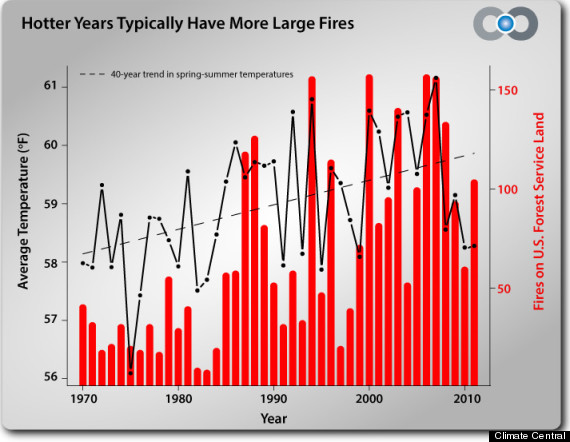
Source: Climate Central, “The Age of Western Wildfires 2012 Report”
- Since 1970, the wildfire season in the western United States has increased by 78 days and the average burn duration of large fires has increased from 7.5 to 37.1 days, according to a study. This increased wildfire trend correlates with an increase in spring and summer temperatures by ~0.9°C and a 1- to 4- week earlier melting of mountain snowpack.
- In 2012, a White House report stated that wildfires burned 9.2 million acres across eight states, reducing air quality, damaging property and costing more than $1 billion.
- The cost of fire suppression and mitigation is the main challenge faced by federal and state agencies battling wildfires. According to a Headwater Economics report, the cost of wildfire protection has more than doubled in the past 15 years, and over 50% of the budget for the US Forest Service is consumed by firefighting.
- Currently, 1% of wildland fires, which are considered catastrophic, are responsible for 30% of the Forest Service’s fire suppression costs. The remaining 70% of suppression costs are generated by the other 99% of fires. In order to address the costs associated with the one percent of fires, the FY 2016 President’s Budget proposes a Fire Suppression Cap Adjustment which would treat catastrophic wildland fires as disasters, and fund their suppression costs outside of the discretionary budget appropriation of the Forest Service. Under the proposed cap adjustment, $855 million would be available to meet suppression costs above the base appropriation. The Fire Suppression Cap Adjustment funds would be accessed by a Secretarial declaration of need and an imminent end of the appropriated discretionary funds.
- With the number of wildfires projected to double in areas of the West by 2050, the cost of battling wildfires will continue to increase. Currently, 1% of wildland fires, which are considered catastrophic, are responsible for 30% of the Forest Service’s fire suppression costs. The remaining 70% of suppression costs are generated by the other 99% of fires. The costs of these large fires often forces the Interior and Agriculture Departments to transfer money from non-suppression. Known as “fire borrowing” or fire transfers”, this activity draws money away for programs intended to reduce the risk of large, catastrophic wildfire risk. Congress must address how we pay for wildfire suppression in order to safeguard accounts meant to improve forest health and mitigate wildfire risk.
- The Stewardship Contracting and Good Neighbor Authorities are critical land management tools that not only improve the health of our forests and reduce the threat of wildfire, but also support our local economies and create jobs for our communities. Democrats supported the permanent reauthorization of both programs in the Farm Bill.
- Committee Democrats support the Collaborative Landscape Restoration Program, which facilitates the reduction of wildfire management costs by reestablishing natural fire regimes and reduce the risk of uncharacteristic wildfire.
- Committee Democrats support President Obama’s proposal to modify the funding strategy for wildfire suppression. In order to address rising costs of wildfire, the FY 2016 President’s Budget proposes funding wildfire suppression at 70 percent of the 10-year average of fire suppression costs. Additionally, the proposal recommends Disaster Cap Adjustment of up to $855 million to address funding needs above the initial allocation. The disaster cap adjustment would allow Congress to provide funding to address bigger than average wildfire seasons through supplemental appropriations that are not subject to discretionary spending limits set by the Budget Control Act of 2011.
Land and Water Conservation Fund
Established in 1965, the Land and Water Conservation Fund (LWCF) was the culmination of a bipartisan effort to protect and enhance our nation’s irreplaceable lands and outdoor recreation opportunities. The vision was simple—to reinvest a portion of energy revenues from offshore oil and gas into conservation of our land, water and recreation resources. LWCF provides outdoor recreational opportunities and landscape-level conservation at the local, state, and federal levels through a trust fund comprised of revenue from
- Receipts oil and gas leases from the Outer Continental Shell (amended 1968, P.L. 90-401)
- Surplus Property Sales
- Motorboat Fuels Tax
LWCF has protected more than 5 million acres and strengthens the ability of land management agencies to manage and provide access to federal, state, and local lands. Congress can appropriate up to $900 million annually from the receipts to fund the account. That has only occurred twice.
LWCF is already paid for
LWCF is the principal source of funds for federal land acquisition by the four land management agencies. (Bureau of Land Management, Forest Service, Fish and Wild Life Service, and National Park Service) Portions or all of many of the nation’s parks, landscapes, and forests were acquired via LWCF.
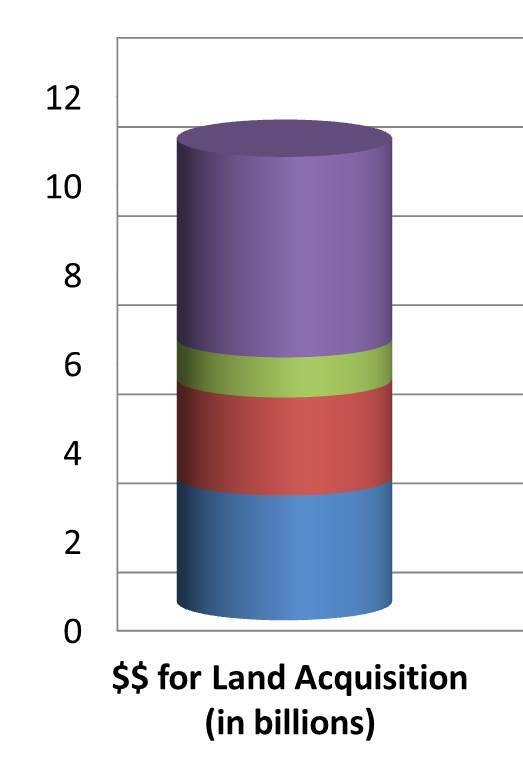
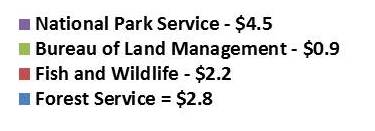
Since funding for LWCF comes primarily from energy revenues, no monies come out of the federal budget. It is Congress’ responsibility to appropriate the funds annually. Over the past 50 years, LWCF has provided over $17.1 billion toward outdoor recreation planning, state and federal lands and waters acquisition; state recreational facilities; and other purposes. There has been $37.1 billion credited to LWCF, leaving an unappropriated balance of $20 billion in the fund.
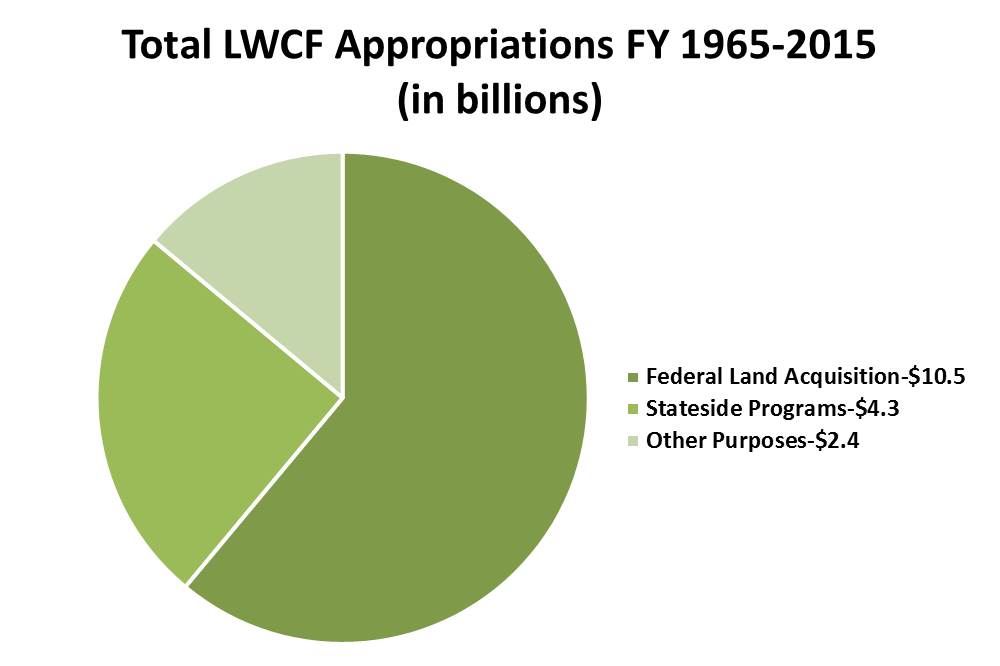
LWCF encourages recreation close to home
The fund’s 42,000 grants to the states totaling almost $4 billion have supported protection of three million acres of recreation lands and over 29,000 recreation facility projects, driven by local priorities and matched with local dollars, to provide close-to-home recreation opportunities, such as playgrounds, hiking trails, and green space, for all Americans
- Traditional State Grants—provides matching grants to the states, DC, and the territories for recreation planning, acquisition of lands and waters, and facilities development
- Competitive State Grants—provide recreation grants for land acquisition and development in densely settled areas (population > 50,000)
- Mandatory Appropriations—12.5% of revenues from certain OCS leasing in the Gulf of Mexico (GOMESA), shared among Gulf producing states and LWCF for coastal restoration projects
LWCF encourages public-private investment
The State Assistance Program has issued over $3 billion in grants and leveraged over $7 billion in non-federal matching funds.
LWCF has enjoyed bi-partisan support
A poll indicates that 88% of voters support continuing to set aside offshore oil and gas drilling fees into the LWCF and 85% of Americans want LWCF to be fully funded.
So what’s the problem?
The legislation for the act expired on September 30, 2015. The 2016 Consolidated Appropriations Act provided a short term extension for the fund, but only through September 30, 2018. Please join the Ranking Member and a bipartisan, bicameral contingent of legislators in supporting permanent re-authorization of LWCF, H.R. 1814.
Legislative efforts in the House and Senate
Congress needs to reauthorize LWCF now; it has strong bipartisan and bicameral support. The following bills have been introduced in the House and Senate:
- H.R. 502 permanently reauthorizes LWCF, creating a set aside of 1.5 percent to promote hunting, fishing and other recreational activities. House Natural Resources Committee Ranking Member Raúl M. Grijalva (D-Ariz.) sponsored the bill and it has 127 bipartisan cosponsors.
- S. 569 is the Senate companion bill. It was introduced by Energy and Natural Resources Committee Ranking Member Maria Cantwell (D-Wash.) and currently has 23 cosponsors.
Swift enactment of either bill will ensure the future success of America’s most important conservation tool.
National Park Service Centennial Act
Ranking Member Raúl M. Grijalva (D-Ariz.) introduced the National Park Service Centennial Act on September 18, 2015, which provides funding and management authority for the National Park Service (NPS) to help the country celebrate the Service’s 100th anniversary next year.
- The bill establishes a National Park Centennial Challenge Fund at the NPS, matched by private donations, to support signature NPS projects through 2018, among other measures.
- The bill’s original cosponsors are Reps Niki Tsongas (D-Mass.), Debbie Dingell (D-Mich.), Jared Huffman (D-Calif.), Alan Lowenthal (D-Calif.) and Donald Norcross (D-N.J.).
- As the National Journal points out, the bill was introduced weeks before governing funding is set to expire. The timing of the bill highlights the popularity of the NPS before Congress shuts down the government as part of a dispute over Planned Parenthood funding.
View the fact sheet for more information on the bill’s major features.

